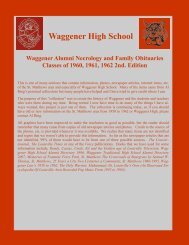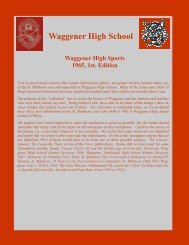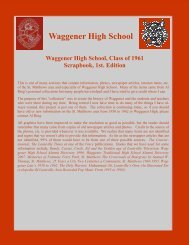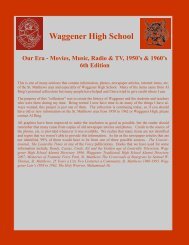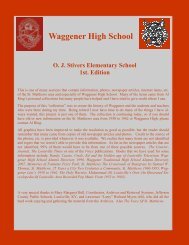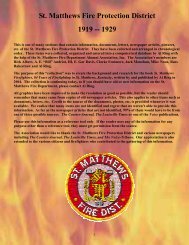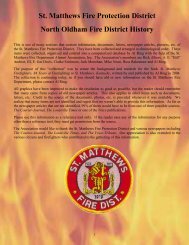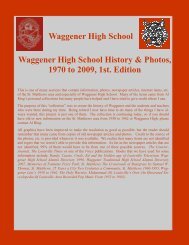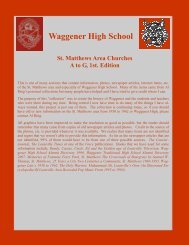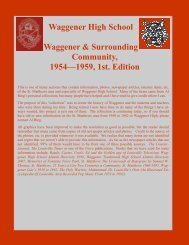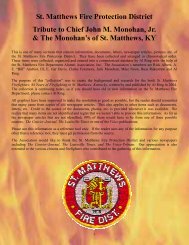Waggener High School - RingBrothersHistory.com
Waggener High School - RingBrothersHistory.com
Waggener High School - RingBrothersHistory.com
- No tags were found...
You also want an ePaper? Increase the reach of your titles
YUMPU automatically turns print PDFs into web optimized ePapers that Google loves.
The Voice of St. Matthews, January 12, 1956: Not Altogether Suburban After 1955St. Matthews Not Altogether Suburban After 1955Several churches were expanded, and three new ones were <strong>com</strong>pleted. The $200,000 St. Matthews Y.M.C.A. was finishedand dedicated, and the new St. Mathews Elementary <strong>School</strong> was opened.Meanwhile the City of St. Matthews moved confidently into the future. Louisville’s last-ditch effort to annex the businessdistrict was vetoed by a Circuit Court jury, and the George Washington Party, headed by Mayor James Noland, faced anelection campaign for the first time in the history of the City, and won and overwhelming vote of confidence from the people.There were some dark spots in the otherwise bright picture. <strong>School</strong>s, Catholic as well as County, were crowded. St. Matthewscould take pride in the fact that its people voted for the proposed 50-cent tax increase to meet new school buildingneeds, but the rest of the County voted so heavily against it, the proposal was defeated. And no easy inexpensive solutioncould be agreed on by State, County, City and local businessmen.The history of a <strong>com</strong>munity however, is more than a recital of business, building and political news. The year 1955 foundSt. Matthews and its neighboring <strong>com</strong>munities developing a rich cultural and sports programs. Sixteen plays were producedhere by the people of the <strong>com</strong>munity, most of them full-length three-act productions. A Great Books group was organized.Little League and Pony League baseball, the St. Matthews Football League, the new Y.M.C.A. building, the Easternand Holy Trinity <strong>High</strong> school athletic programs, and the swimming and golf programs of the country clubs, along withthe less well publicized efforts, reached into thousands of homes until the entire <strong>com</strong>munity felt their bracing effects.The sports program was probably closest to the hearts of most of the people, for it involved, in the main, their children.Let’s begin there.We were all proud when the Eagles of Eastern <strong>High</strong> <strong>School</strong>, coached by Roy Adams, defeated the Fern Creek Tigers 75-62in March, to win their second consecutive Jefferson County basketball championship. Led by Hugh Durham and Dick Ewingthe Eagles registered victories over Manual (60-59), Atherton (68-54), Valley (75-49) and three wins over Fern Creek,for a 13-1 record for the regular season and 14-8 altogether.(Durham a great trackman and football halfback as well as a basketball star, was awarded the Flying Dutchman’s Corn Cobaward, given annually to an outstanding sportsman.)The 1955 Eagle grid squad, losing some close, tough ones, had a bad year on paper, winning only three, dropping four, andtying two. It was the first time in the six-year history of the school that an Eastern team, coached by Emmet Goranfln, hada losing year. There was a bright spot. Little Louis Roos, a junior playing his first year of varsity ball, captured the Countyscoring title, with a total of 60 points. (Charlene Scheibel of St. Matthews was crowned football queen.)By the end of the year, the Eagle basketball team was in the midst of a new 18-game regular season, and had won three outof its first four, including a victory over mighty Lafayette, in the Louisville Invitational Tournament. Eastern whipped astrong Flaget team, before bowing to Manual.Holy Trinity became a high school in the fall of 1955, and coached by Jeep Quire, entered its first season of varsity basketballand football. The players were all juniors and their <strong>com</strong>plete lack of varsity experience showed, as they won only twoout of eight football games, and two out of their first six basketball contests.The third season of St. Matthews Little League Baseball, under the presidency of Charles Siegel, was an almost unqualifiedsuccess.Playing for the District championship, the St. Matthews National League All-Stars and the St. Matthews American LeagueAll-Stars knocked off all the <strong>com</strong>petition, and faced each other in the finals.The Americans in the opening round had defeated the Algonquin All-Stars 5-1, when Steve Graef blasted two home runsand a single, while his team mates, pitchers John Cardot and John Thompson, were giving up only four hits.The Nationals, meanwhile, defeated Brandenberg 10-0 behind Tim Wright’s three-hit pitching, with a nine-hit assault ledby Paul Charron, Rich Stokes, Dave Leibson, and Charlie Kane.In regular play, the Ermanns won the National League pennant for the first time, their 12-6 record good enough to edge thesecond-place Lions by one game, in the American League, the Models won their second pennant in three years with a 12-5record, two games better than the second place Showers.Rich Stokes of the Ermanns staged a sort of one-man show in the National League. He tied with George Trbble of the Lionsfor pitching honors (each boy won six and lost one) and led the league in strikeouts with 99. In 45 innings, Stokes allowedonly eight hits and nine runs, and pitched one no-hitter and four one-hitters.Playing third base when he was not pitching, Stokes, in his third year of Little League play, was also the National League’soutstanding hitter, capturing three titles—hitting with a .449 average, runs-batted-in with 27, and home runs, with six.



